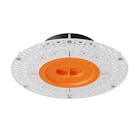Date Announced: 08 Oct 2009 The rapidly expanding use of bluish-white outdoor lighting threatens visibility at night and jeopardizes the nocturnal environment worldwide.This surge is fueled by the promise of energy savings and reduced lighting maintenance. The demand for energy efficient lighting is a laudable imperative. This effort has resulted in a new generation of electric light sources such as LEDs and induction lamps that emit a cold, bluish white light. The blue tone of the light is a result of how the light source operates and it is not visually necessary. The blue portion of the color spectrum produces only a small percentage of light that is useful to the human eye.Unfortunately, bluish light produces high levels of light pollution with significant environmental impact. These lights are known to increase glare and compromise human vision, especially in the aging eye. Short wavelength light also increases sky glow disproportionately. In addition, blue light has a greater tendency to affect living organisms through disruption of their biological processes that rely upon natural cycles of daylight and darkness, such as the circadian rhythm. For only a modest improvement in outdoor lighting efficiency, these new sources dramatically escalate the environmental damage caused by artificial lighting.Some manufacturers and government agencies are misrepresenting the visual effectiveness of these bluish-white light sources and the environmental impacts are not being considered. IDA discourages the use of bluish-white lamp sources with a Correlated Color Temperature above 3000 Kelvin. Developers of light sources should be required to refine their products to limit blue light at wavelengths shorter than 500 nm.IDA encourages government and other concerned parties to support additional scientific research on this subject. This research will help to understand fully the impact of bluish white light and guide the evolution of lighting technology to protect human health and the nocturnal environment while providing safe and efficient outdoor lighting.Refrring to the graph, human visual sensitivity is primarily in the green and yellow part of the spectrum and is depicted by the thin solid line. Circadian rhythms are controlled by light emitted within the dashed curve. The color of light emitted by a typical bluish-white 5500 Kelvin LED is depicted by the bold line. A large portion of light emitted by this light source falls outside of the human photopic vision range, and falls within the circadian rhythm curve. IDA recommends limiting blue light emitted below 500 nm, as indicated by the shaded section of the graph.About the IDAThe IDA is a 501 (c) (3) not-for-profit organization whose mission is to preserve and protect the nighttime environment and our heritage of dark skies through environmentally responsible outdoor lighting. The information above was developed by the IDA Technical Committee using published research and input from professional members of the environmental, astronomical and lighting design communities.
Contact
Pete Strasser Managing Director, International Dark-Sky Association 3225 North First Avenue Tucson, AZ 85719, USA Tel. +1-520-293-3198 x 405
E-mail:[email protected]
Web Site:www.darksky.org






